You simply need to know - Facts & Figures
Universe
Cosmological magnetic fields
Magnetic fields are observed everywhere in the universe. The magnetic field of the Galaxy was first discovered in 1949 by optical polarization.
Cosmological magnetic fields
We have no direct observational evidence for the first cosmological magnetic fields. The fields, with observed intensities of B ~ 2 − 10 Gauss today must have started at a lower level and become amplified by some mechanism at some cosmological stage. The “battery effect", generates magnetic fields of B ~ 10−20 G at the most. Several mechanisms to produce the seed fields at different epochs of the universe proposed, that turbublence in the radiation-dominated era produces the weak seed fields of presently 10−8 G. Some progress has been made recently in the studies of the evolution of primordial magnetic fields. Some early papers considered that if an intergalactic magnetic field exists with B ~ 10−8 G, it could be compressed by galactic rotation to B~10−5 G, intensities that are actually observed in galaxies. This was supported by some papers that claimed the detection of a lower limit of intergalactic magnetic field with B above 3x10−9 G.
Article Src: DOI: 10.1088/1009-9271/2/4/293

Cosmic magnetism
‘Cosmic Magnetism’ refers to the magnetic fields of our universe, which are present in planets, stars, galaxies and the universe at large.
Cosmic magnetism
They play a major role as without a magnetic field around our planet to protect us from cosmic radiation, life would not be possible on Earth. However we do not understand where this magnetism comes from, what generated it, and what influence it has on the universe that surrounds us. The study of cosmic magnetism is comparable to the study of common household magnets on iron filings. When approaching a magnet to a lump of iron filings, these align in a pattern delineating the shape of the magnetic field. But the cosmic magnets we study are scaled to extreme sizes, and instead of using iron filings we use radio waves emitted by celestial objects. The radio waves, in passing through magnetic fields, are affected by them and some of their properties change. We call this polarisation.
Article Src: https://www.skatelescope.org/newsandmedia/outreachandeducation/skawow/cosmic-magnetism

Neutron stars magnetism
The magnetic field strength on the surface of neutron stars ranges from 104 to 1011 tesla. These are orders of magnitude higher than in any other object: For comparison, a continuous 16 T field has been achieved in the laboratory and is sufficient to levitate a living frog due to diamagnetic levitation.
Neutron stars magnetism
The neutron stars known as magnetars have the strongest magnetic fields, in the range of 108 to 1011 tesla, and have become the widely accepted hypothesis for neutron star types soft gamma repeaters (SGRs) and anomalous X-ray pulsars (AXPs). The magnetic energy density of a 108 T field is extreme, greatly exceeding the mass-energy density of ordinary matter. Fields of this strength are able to polarize the vacuum to the point that the vacuum becomes birefringent. Photons can merge or split in two, and virtual particle-antiparticle pairs are produced. The field changes electron energy levels and atoms are forced into thin cylinders. Unlike in an ordinary pulsar, magnetar spin-down can be directly powered by its magnetic field, and the magnetic field is strong enough to stress the crust to the point of fracture. Fractures of the crust cause starquakes, observed as extremely luminous millisecond hard gamma ray bursts. The fireball is trapped by the magnetic field, and comes in and out of view when the star rotates, which is observed as a periodic soft gamma repeater (SGR) emission with a period of 5–8 seconds and which lasts for a few minutes. The origins of the strong magnetic field are as yet unclear. One hypothesis is that of "flux freezing", or conservation of the original magnetic flux during the formation of the neutron star. If an object has a certain magnetic flux over its surface area, and that area shrinks to a smaller area, but the magnetic flux is conserved, then the magnetic field would correspondingly increase. Likewise, a collapsing star begins with a much larger surface area than the resulting neutron star, and conservation of magnetic flux would result in a far stronger magnetic field. However, this simple explanation does not fully explain magnetic field strengths of neutron stars.
Article Src: https://en.wikipedia.org/wiki/Neutron_star#cite_note-reisenegger-35
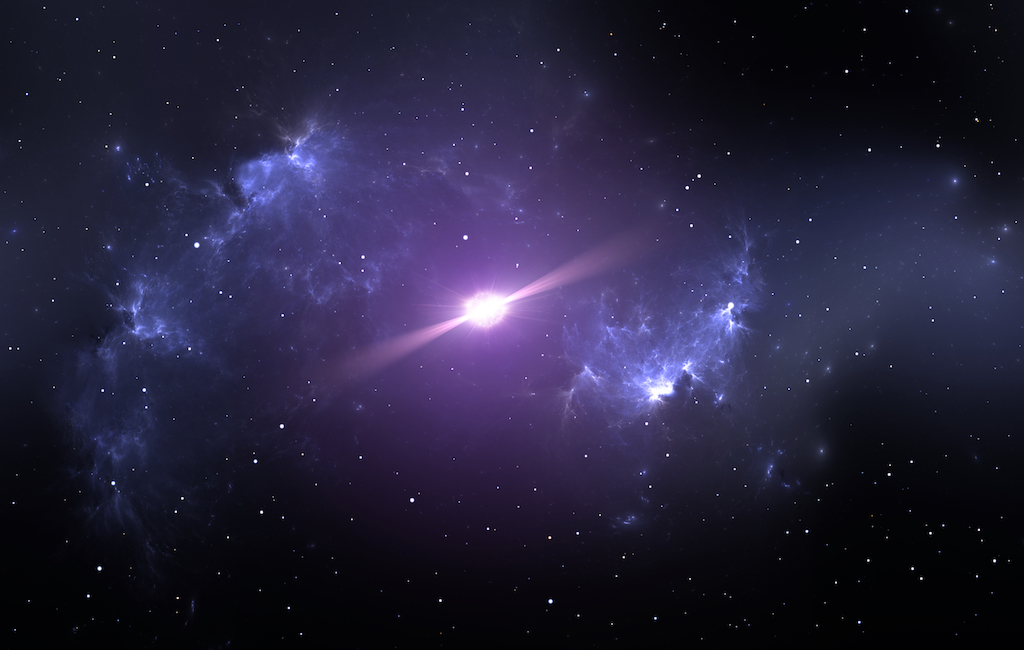
White Dwarfs magnetism
White dwarfs (WD) are formed in catastrophic astrophysical events such as supernova explosions. Observations have shown that the observed surface magnetic fields in white dwarfs can be so strong as 109 G.
White Dwarfs magnetism
White dwarfs (WD) are formed in catastrophic astrophysical events such as supernova explosions. It is also in these events that other forms of compact objects, as neutron stars or black holes, can be created. It is understood that stars born with masses less than 8 solar masses end up their evolutions as white dwarfs. With a typical composition mostly made of carbon, oxygen, or helium, endowed with a background of electron-degenerate matter, white dwarfs are extremely dense objects, with a mass comparable to that of the Sun, which is distributed in a volume comparable to that of the Earth. As a result, the densities in WD’s can reach values up to 1011 g/cm3 at the stellar center. The mass of white dwarfs is primarily given by the total mass of the nuclei, whereas the main contribution to the pressure comes from the electrons. In addition, was found that there is a limit in the stellar mass, beyond which degenerate white dwarfs are unstable. This critical mass is the so-called Chandrasekhar limit and is about 1.4 M. Although the internal magnetic fields of these stars cannot be directly constrained by observations, they can possess central magnetic fields as large as 1013 G.
Article Src: doi :10.1088/1742-6596/861/1/012015

Jupiter's Magnetic Field
The first clue to Jupiter's extraordinary magnetic field came with the detection of strong radio frequency emissions from the planet.
Jupiter's Magnetic Field
This implied accelerating charged particles and a charged particle region around the planet similar to the Earth's van Allen belts. But the emissions were several thousand times stronger than those from the van Allen belts. When spacecraft reached the vicinity of Jupiter, they found that its magnetosphere was about 30 million km across, larger than the entire Sun. The interaction of the solar wind with this magnetosphere elongates it on the outward side to a distance beyond Saturn's orbit, about 4 A.U. past Jupiter. From analysis of the radio frequency emissions, it is implied that the magnetic pole strength of Jupiter is nearly 20,000 times stronger than the Earth's pole strength. That does not, however, mean that the surface magnetic fields are that much stronger than those of Earth. The surface magnetic field strengths are about 14G at the north pole, 11G at the south pole and 4G at the equator. While 20,000 times the intrinsic strength of Earth's magnetic dynamo is incredible, it is approximately a dipole field. Given that Jupiter's radius is almost 12 times that of Earth, and that dipole field strength drops off with the cube of the radius perpendicular to the dipole axis, one would project a surface field on the order of 7 Gauss at the equator from just the ratios of the equatorial diameters.
Article Src: http://hyperphysics.phy-astr.gsu.edu/hbase/Solar/jupmag.html
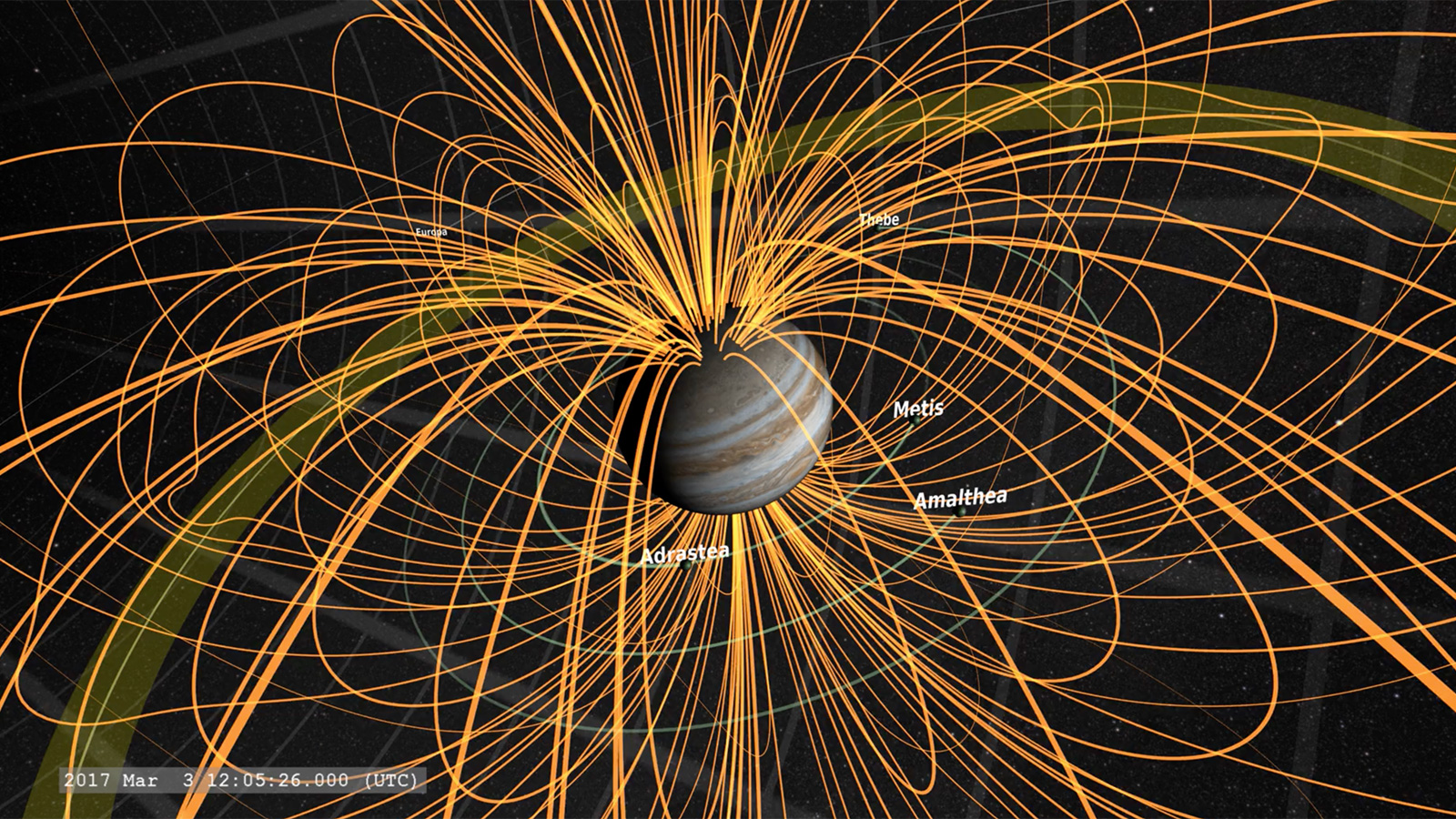
Mars' magnetic field
The first orbiter missions to Mars that carried magnetometers did not find conclusive evidence for an internal magnetic field.
Mars' magnetic field
This changed in 1997 when the Mars Global Surveyor approached the planet’s surface to within 100 km during aerobraking maneuvers and found locally strong fields of crustal origin. Their amplitude is in excess of 1000 nT at satellite altitude in some regions, implying local surface field strengths of several thousands of nT. This is significantly more than typical crustal field contributions on Earth, the Moon, or Mercury. The distribution is uneven, with strong magnetization in parts of the southern highlands of Mars and weak or absent magnetization in the northern lowlands. The only plausible cause for its acquisition is the existence of a strong global field generated by an early dynamo that is now extinct. From the magnetization associated with large dated impact basins (or its absence) it has been estimated that the dynamo ceased to operate 4.1 billion years ago.
Article Src: https://doi.org/10.1093/acrefore/9780190647926.013.31
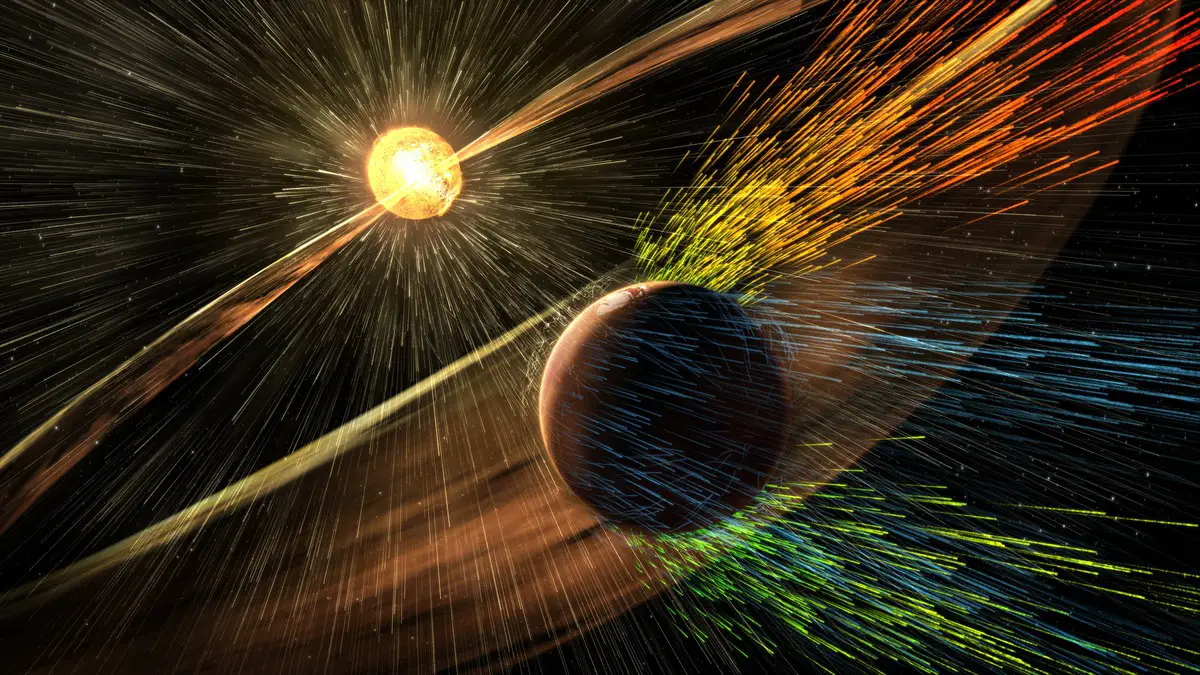
Uranus and Neptune's (U/N) magnetic field
Uranus and Neptune (U/N) are expected to contain substantial compositions of H2O, NH3, CH4 etc, which are called “ices”, and thus U/N are called the Ice Giant Planets.
Uranus and Neptune's (U/N) magnetic field
Around 2010 we became aware of the fact that the magnetic fields of U/N discovered in the 1980s are anomalous relative to other known magnetic fields in the Solar System. It also became apparent that a likely explanation for those unusual magnetic fields could be put together based on experimental results we had measured. Metallic fluid H is of particular importance in this regard because of its dominant chemical abundance and large measured electrical conductivities versus pressure. Remarkably, although the key discovery was that of metallic fluid H, the rest of the explanation for U/N is virtually independent of exact chemical compositions, pressures and temperatures in their “icy” cores. The main reason is the fact is that the boundary region between their Gas envelopes and “Ice” cores occurs at interior pressures of ~100 GPa near which dominant contributions to the unusual magnetic fields are probably made by convecting metallic fluid H. At greater planetary depths, whatever nebular molecules did accrete to form U/N probably decomposed and re-reacted to form unknown complex chemical mixtures. The magnetic fields of U/N are both ~2x10-5 Tesla, comparable to that of Earth. If the measured magnetic fields of U/N are force-fit to effective dipolar fields, the effective magnetic axes are tilted 590 and 470 , respectively, from their respective rotational axes and the effective dipole centers are offset by ~0.33 RU and ~0.55 RN, respectively, from the centers of U/N, where RU and RN are the radii of U/N. In contrast, the magnetic fields of Earth, Saturn, Jupiter and its moon Ganymede are dipolar with their magnetic axes aligned within a few degrees of their respective rotational axes and the centers of their dipoles offset by a few percent of outer radii from their physical centers. Pressures and temperatures in U/N range up to ~700 GPa and 7000 K near their centers. Dynamic compression with a two-stage light-gas gun can achieve pressures up to ~300 GPa (3x106 bar=3 Mbar) and temperatures up to several 1000 K in fluids representative of outer portions of U/N in which those external magnetic fields are made. From ~1980 to ~2010 an enormous body of experimental data was measured on molecular liquids compressed dynamically with a two-stage light-gas gun to pressures ranging from ~20 GPa to ~200 GPa with corresponding temperatures ranging from several 100 K to several 1000 K.
Article Src: https://doi.org/10.1063/1.4971621
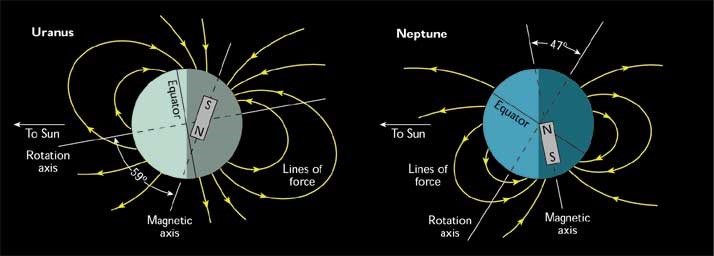
Saturn's magnetic field
The north-south asymmetry of Saturn's internal magnetic field was directly measured with a northward offset of Saturn's magnetic equator by ~ 0.0468 RS (2820.5 km).
Saturn's magnetic field
The measurements further demonstrated that the northward offset of Saturn's magnetic equator varies with cylindrical radial distance from Saturn. Limited “longitudinal” variation of Saturn’s magnetic equator revealed that Saturn's internal magnetic field is exceptionally axisymmetric, with a dipole tilt less than 0.01 degrees. The azimuthal magnetic field measured near the periapsis arise from a low-latitude field-aligned current system confined to magnetic field lines inside Saturn's tenuous D-ring. Although almost perfectly axisymmetric, Saturn's internal magnetic field exhibits features on many characteristic length scales in the latitudinal direction.
In addition to the spherical harmonic analysis, we employed the Green's function to construct new internal field models for Saturn. Expressed using Gauss coefficients, Saturn's internal magnetic field features prominent dipole, quadrupole, and octupole terms, while the degree 4 to degree 11 terms are on the order of 100 nT or less. Examining Br at 0.75 RS, the degree 4 to 11 contributions correspond to latitudinally banded structure with characteristic width similar to the off-equator zonal jets observed in the atmosphere of Saturn. Saturn's internal magnetic field beyond 600, the small-scale features in particular, are less well constrained by the available measurements. This is mainly due to incomplete spatial coverage in the polar region.
Article Src: https://doi.org/10.1016/j.icarus.2019.113541
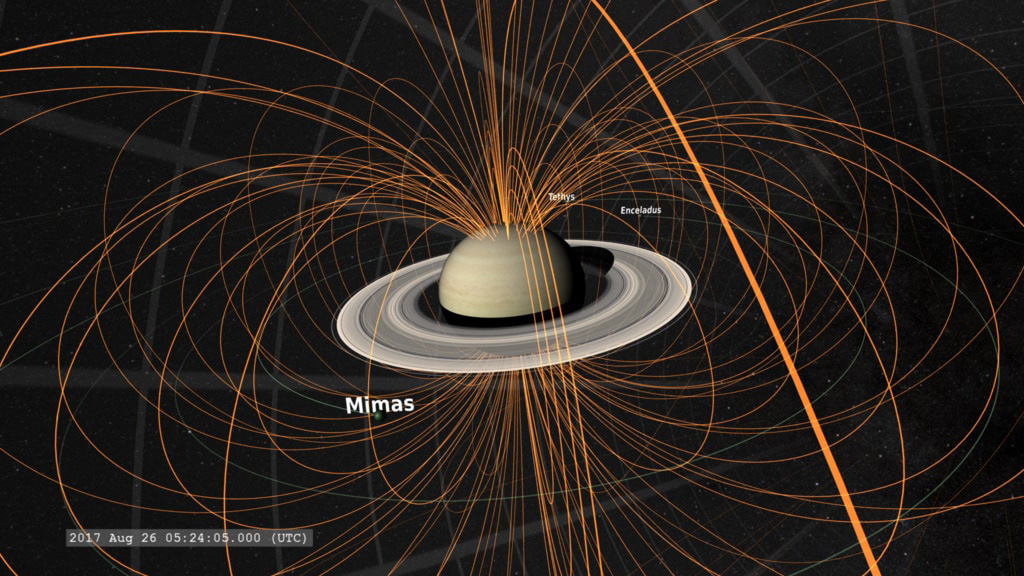
Sun's magnetic field
The Sun has a general, weak dipole magnetic field with a north and south magnetic pole of perhaps 0.001 Tesla in strength.
Sun's magnetic field
Similar to our own planet, the sun is like a huge bar magnet with a north and a south pole producing a magnetic field. But the sun's magnetic field is about twice as strong as the Earth's and much, much larger, extending well beyond the farthest planet in the solar system. The sun's field is also a jumbled mess. As the sun rotates, the plasma near the poles rotates more slowly than the plasma near the equator. This off-rhythm spinning causes the magnetic field to get twisted and tangled into massive bundles. As the fields get more and more tangled, they burst through the sun's surface, leaving marks we know as sunspots. Around a sunspot, the magnetic field can reach as high as 0.4 tesla, which is around 4,000 times stronger than the field at the sun's poles. If the north pole of the Sun has a positive magnetic polarity that points out of the Sun, then the westernmost leader spot of the pair in that hemisphere – the one that is ahead in the direction of rotation – will always be positive, the follower negative.
In the southern hemisphere, the polarities will be reversed. This orderly arrangement, known as Hale’s law of polarity, is described by a simple model in which the magnetic field gets amplified, coiled, and wrapped around inside the Sun, looping through the photosphere to make the bipolar sunspot pairs. Such a magnetic field is must be generated by a solar dynamo located at the base of the convection zone. The highly magnetized realm in, around and above bipolar sunspot pairs or groups is a disturbed area called an active region. Neighboring sunspots of opposite polarity are joined by magnetic loops that rise into the overlying atmosphere, so an active region consists mainly of sunspots and the magnetic loops that connect them. All of this activity varies in step with the periodic 11-year change in the total number of sunspots. The existence of this sunspot cycle was first suggested in the early 1840s by Samuel Heinrich Schwabe, a pharmacist and amateur astronomer of Dessau, Germany, who diligently and meticulously observed the Sun for more than forty years, noting a decade-long variation in their total numbers.
Article Src: https://nationalmaglab.org/fieldsmagazine/archives/magnetic-field-of-sun
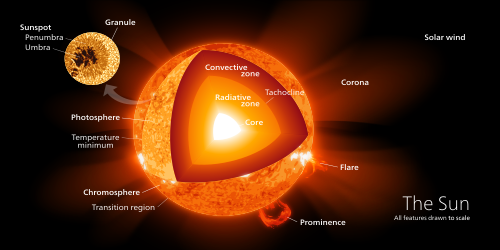
Solar flares
Solar flares result from the abrupt release of free magnetic energy that has previously been stored in the coronal magnetic field by flux emergence and surface motions. Solar flares strongly affect the Sun’s atmosphere as well as the Earth’s environment.
Solar flares
Quantifying the maximum possible energy of solar flares of the present-day Sun, if any, is thus a key question in heliophysics. The largest solar flares observed over the past few decades have reached energies of a few times 1032 erg, possibly up to 1033 erg. Flares in active Sun-like stars reach up to about 1036 erg. In the absence of direct observations of solar flares within this range, complementary methods of investigation are needed to assess the probability of solar flares beyond those in the observational record. Firstly, commonly observed solar conditions lead to modeled magnetic fluxes and flare energies that are comparable to those estimated from observations. Secondly, the 30% of the area of sunspot groups are typically involved in flares.
This is related to the strong fragmentation of these groups, which naturally results from sub-photospheric convection. When the model is scaled to 30% of the area of the largest sunspot group ever reported, with its peak magnetic field being set to the strongest value ever measured in a sunspot, it produces a flare with a maximum energy of ∼6 × 1033 erg. The results of the model suggest that the Sun is able to produce flares up to about six times as energetic in total solar irradiance fluence as the strongest directly observed flare of Nov. 4, 2003.
Article Src: DOI: 10.1051/0004-6361/201220406

Sunspots
Sunspots are the most prominent magnetic feature on the Solar surface (sometimes they can be seen with the naked eye). The number of sunspots visible on the Solar surface changes fairly regularly in time.
Sunspots
The number of sunspots increases and decreases over a period of 11 years. This is called the Solar cycle. Moreover, the position of sunspots also changes in time. In 11 years sunspots move from high latitudes to the equator. By plotting the position of the sunspots versus time the so called butterfly diagrams is obtained. Sunspots appear as dark spots on the surface of the Sun. Temperatures in the dark centres of sunspots drop to about 3700 K (compared to 6000 K for the surrounding photosphere). They occur where magnetic fields suppress convection of hot matter to the surface. They typically last for several days, although the very large ones may live for several weeks. Sunspots are magnetic regions on the Sun with magnetic field strengths of up to 0.2- 0.3 T.
The field is strongest in the darker parts of the sunspots - the umbra, and the field is weaker and more horizontal in the lighter part - the penumbra. Sunspots usually come in groups with two sets of spots. One set will have positive or north magnetic field while the other set will have negative or south magnetic field. These sets of north-south magnetic field sunspots are usually oriented east to west, and the orientation on northern hemisphere is always opposite to the orientation on the southern hemisphere.
Article Src: DOI: 10.1051/0004-6361/201220406

You simply need to know - Facts & Figures
Earth
Solar Wind
Solar Wind are the most prominent magnetic feature on the Solar surface (sometimes they can be seen with the naked eye). The number of Solar Wind visible on the Solar surface changes fairly regularly in time.
Solar Wind
It flows with supersonic speed of about 500 km s− 1 and consists mainly of electrons and protons, with an admixture of 5% helium ions. Because of the high conductivity, the solar magnetic field is ‘frozen’ in the plasma (as in a superconductor; see succeeding text) and drawn outward by the expanding solar wind. Typical values for electron density and temperature in the solar wind near the Earth are 5 cm− 3 and 105 K, respectively. The interplanetary magnetic field strength is of the order of 5–10 nT near the Earth's orbit. When the solar wind impinges on the Earth's dipolar magnetic field, it cannot simply penetrate it, but is slowed down and, to a large extent, deflected around it. Since the solar wind hits the obstacle with supersonic speed, a bow shock wave is generated, where the plasma is slowed down and a substantial fraction of the particles' kinetic energy is converted into thermal energy. The region of thermalized subsonic plasma behind the bow shock is called the magnetosheath. Its plasma is denser and hotter than the solar wind plasma and the magnetic field strength has higher values in this region. Mean values of solar-wind parameters at the Earth's orbit are:
Particle density, N: N ≈ 10 million particles m−3 (5 million electrons and 5 million protons)
Velocity, V: V ≈ 375 000 m s−1 and V ≈ 750 000 m s−1
Flux, F: F ≈ 1012 to 1013 particles m−2 s−1
Temperature, T: T ≈ 120 000 K (protons) to 140 000 K (electrons)
Magnetic field strength, H: H ≈ 6 × 10−9 T = 6 nT = 6 × 10−5 G
Article Src: https://doi.org/10.1016/B0-12-369396-9/00078-2
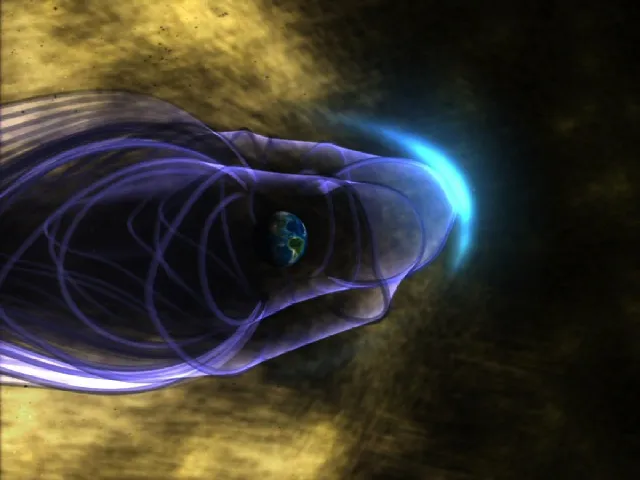
Solar Dynamo
The Sun's magnetic field dominates the solar atmosphere. It produces all the observed energetic phenomena, and displays an 11-year activity cycle. Despite notable advances in our knowledge and understanding of solar magnetism using observations from the Ulysses, SOHO, and Hinode missions - and recent theoretical models and numerical simulations – the details of the so-called "solar dynamo" processes that power the Sun's magnetic activity cycle are not yet fully understood.
Solar Dynamo
The Sun's global magnetic field is generated by a dynamo generally believed to be seated in the tachocline, the shear layer at the base of the convection zone. According to flux-transport dynamo models, meridional circulation and other near-surface flows transport magnetic flux from decaying active regions to the poles.
There subduction carries it to the tachocline to be reprocessed for the next cycle. A key objective of the Solar Orbiter mission is to measure and characterize the flows that transport the solar magnetic fields: complex near-surface flows, the meridional flow, and the differential rotation at all latitudes and radii. We need detailed knowledge of magnetic flux transport near the poles to understand the solar dynamo and the regular polarity reversal of the global magnetic field. Solar Orbiter's imaging of the properties and dynamics of the polar region during the out-of-the-ecliptic phase of the mission (reaching heliographic latitudes of 25° during the nominal mission and as high as 34° during the extended mission) will provide vital new constraints for models of the solar dynamo.
Article Src: https://sci.esa.int/web/solar-orbiter/-/51172-how-does-the-solar-dynamo-work-and-drive-connections-between-the-sun-and-the-heliosphere
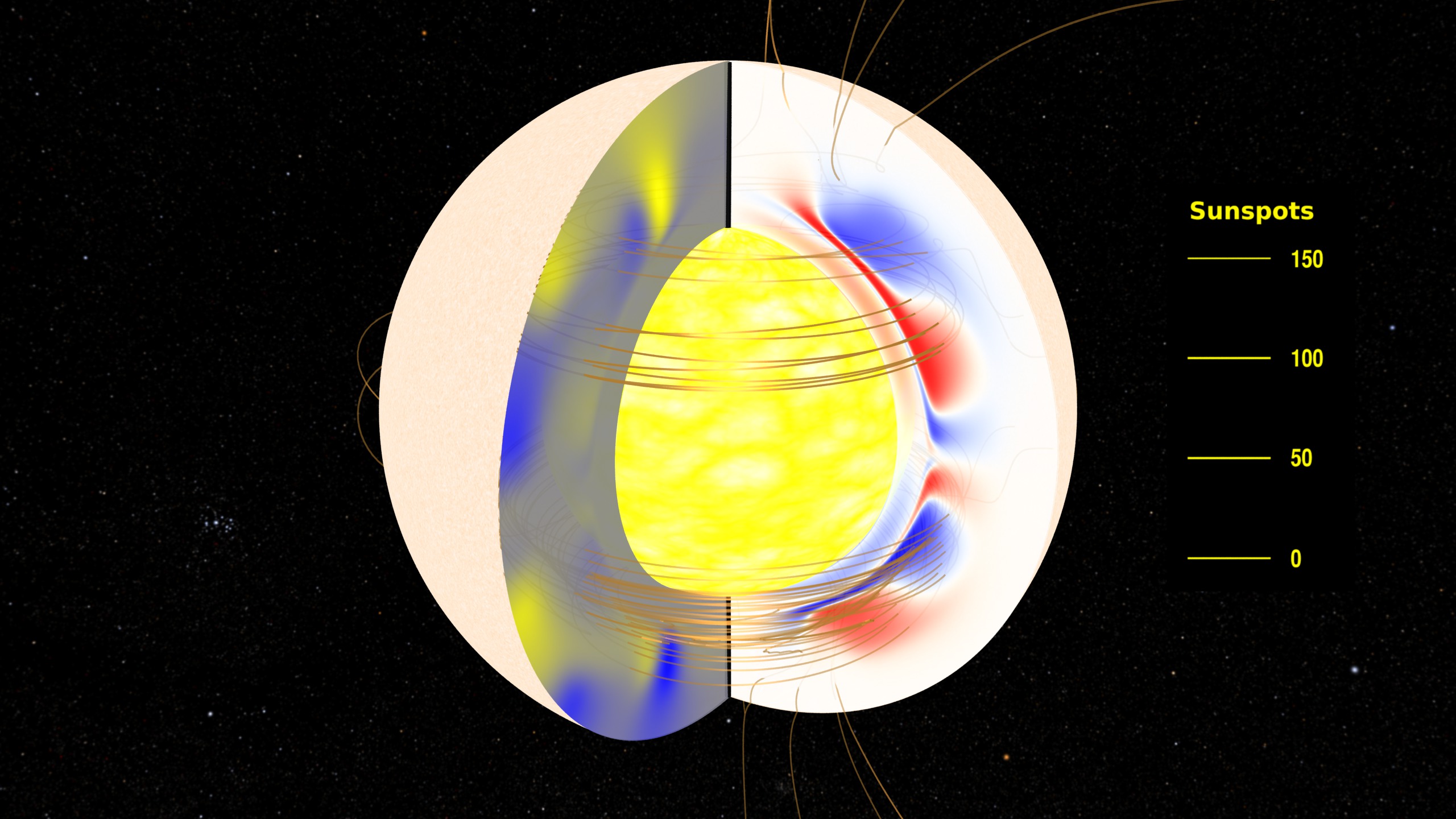
Geomagnetic storm
Geomagnetic storm, also called magnetic storm or solar storm, disturbance of Earth’s upper atmosphere brought on by coronal mass ejections—i.e., large eruptions from the Sun’s outer atmosphere, or corona.
Geomagnetic storm
The material associated with these eruptions consists primarily of protons and electrons with an energy of a few thousand electron volts. This material, called plasma, moves through the interplanetary medium at speeds from less than 10 km (6 miles) per second to more than 2,000 km (1,200 miles) per second, so that the ejected material reaches Earth in approximately 21 hours. The pressure of the incoming plasma is transmitted to the outer edge of Earth’s magnetosphere; this causes an increase in the observed geomagnetic field at the ground, perhaps through hydromagnetic waves. During a few minutes—the sudden-commencement phase—of the storm, the horizontal component of the geomagnetic field increases suddenly over the entire globe. The increase persists for two to six hours and is classified as the initial phase of the storm.
In response to this unstable condition, the newly created magnetic lines in the interior of the tail contract rapidly, thereby sending plasma from the neutral sheet of the magnetosphere toward the night side of Earth. This plasma injection results in intense auroral displays in the polar regions, while the contractions are observed on Earth as a severe magnetic disturbance known as a polar substorm. This portion of the storm is followed by the storm’s main phase, lasting 12 to 48 hours, during which the horizontal component of the field decreases, because of the injection or inflation of the magnetosphere by the incoming plasma. In the last stages, or recovery phase, the newly injected plasma drains slowly over several days into the interplanetary medium or the atmosphere, and the geomagnetic field approaches its pre-storm condition.
Article Src: https://www.britannica.com/science/geomagnetic-storm

Moon's magnetic field
The moon keeps the same face turned toward the earth because it is tidally evolved. The quest to understand the phases of the moon, the cycle of lunar and solar eclipses, the ocean tides, and the motion of the moon in the sky served as a basis for early scientific investigation.
Moon's magnetic field
Planetary magnetic fields are believed to be caused by strong convective currents in planetary cores. These currents require for their production complete melting over of a large region of the planet’s interior and rapid rotation of the planet. Because the moon has neither a large core or rotates rapidly, it has no appreciable magnetic field. However, analysis of remnant magnetism in lunar rock indicates that the moon had a weak magnetic field ( 1/20 that of the earth’s current field) around the time of the formation (3.9–3.1 billion years ago). The major geologic processes occurring on the moon today are infrequent cratering events and “gardening” of the regolith by micrometeorites and the solar wind.
Article Src: https://doi.org/10.1016/B0-12-227410-5/00460-9

Earth's magnetic field
Earth's magnetic field, also known as the geomagnetic field, is the magnetic field that extends from the Earth's interior out into space, where it interacts with the solar wind, a stream of charged particles emanating from the Sun.
Earth's magnetic field
The magnetic field is generated by electric currents due to the motion of convection currents of a mixture of molten iron and nickel in the Earth's outer core: these convection currents are caused by heat escaping from the core, a natural process called a geodynamo. The magnitude of the Earth's magnetic field at its surface ranges from 25 to 65 μT (0.25 to 0.65 gauss). As an approximation, it is represented by a field of a magnetic dipole currently tilted at an angle of about 11 degrees with respect to Earth's rotational axis, as if there were an enormous bar magnet placed at that angle through the center of the Earth. The North geomagnetic pole actually represents the South pole of the Earth's magnetic field, and conversely the South geomagnetic pole corresponds to the north pole of Earth's magnetic field (because opposite magnetic poles attract and the north end of a magnet, like a compass needle, points toward the Earth's South magnetic field, i.e., the North geomagnetic pole near the Geographic North Pole). As of 2015, the North geomagnetic pole was located on Ellesmere Island, Nunavut, Canada. While the North and South magnetic poles are usually located near the geographic poles, they slowly and continuously move over geological time scales, but sufficiently slowly for ordinary compasses to remain useful for navigation. However, at irregular intervals averaging several hundred thousand years, the Earth's field reverses and the North and South Magnetic Poles respectively, abruptly switch places. These reversals of the geomagnetic poles leave a record in rocks that are of value to paleomagnetists in calculating geomagnetic fields in the past. Such information in turn is helpful in studying the motions of continents and ocean floors in the process of plate tectonics. The intensity of the field is often measured in gauss (G), but is generally reported in nanoteslas (nT), with 1 G = 100,000 nT.
A nanotesla is also referred to as a gamma (γ). The Earth's field ranges between approximately 25,000 and 65,000 nT (0.25–0.65 G). By comparison, a strong refrigerator magnet has a field of about 10,000,000 nanoteslas (100 G). A map of intensity contours is called an isodynamic chart. As the World Magnetic Model shows, the intensity tends to decrease from the poles to the equator. A minimum intensity occurs in the South Atlantic Anomaly over South America while there are maxima over northern Canada, Siberia, and the coast of Antarctica south of Australia. Near the surface of the Earth, its magnetic field can be closely approximated by the field of a magnetic dipole positioned at the center of the Earth and tilted at an angle of about 11° with respect to the rotational axis of the Earth. The dipole is roughly equivalent to a powerful bar magnet, with its south pole pointing towards the geomagnetic North Pole. This may seem surprising, but the north pole of a magnet is so defined because, if allowed to rotate freely, it points roughly northward (in the geographic sense). Since the north pole of a magnet attracts the south poles of other magnets and repels the north poles, it must be attracted to the south pole of Earth's magnet. The dipolar field accounts for 80–90% of the field in most locations. At present, the overall geomagnetic field is becoming weaker; the present strong deterioration corresponds to a 10–15% decline over the last 150 years and has accelerated in the past several years; geomagnetic intensity has declined almost continuously from a maximum 35% above the modern value achieved approximately 2,000 years ago. The rate of decrease and the current strength are within the normal range of variation, as shown by the record of past magnetic fields recorded in rocks. The nature of Earth's magnetic field is one of heteroscedastic fluctuation. An instantaneous measurement of it, or several measurements of it across the span of decades or centuries, are not sufficient to extrapolate an overall trend in the field strength. It has gone up and down in the past for unknown reasons. Also, noting the local intensity of the dipole field (or its fluctuation) is insufficient to characterize Earth's magnetic field as a whole, as it is not strictly a dipole field. The dipole component of Earth's field can diminish even while the total magnetic field remains the same or increases.
Article Src: https://en.wikipedia.org/wiki/Earth%27s_magnetic_field
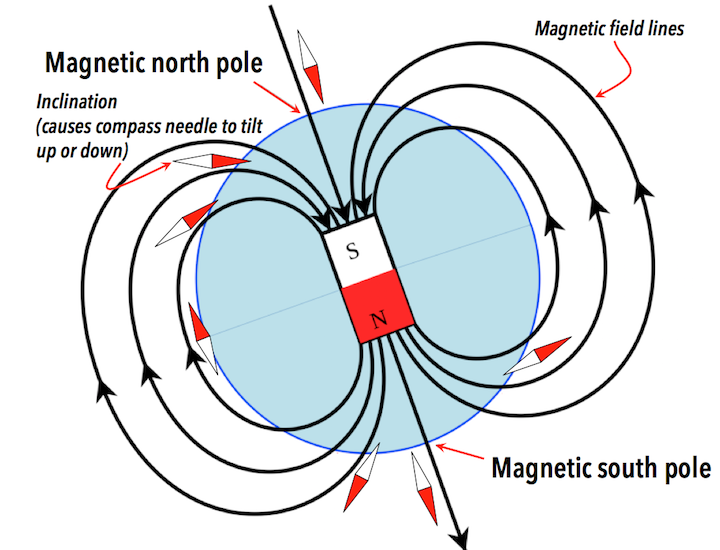
Geomagnetic dynamo
Observations of the magnetic field of Earth’s surface indicate that more than 90 percent of this field arises from sources internal to the planet. A variety of mechanisms for generating this field have been proposed, but at present only the geomagnetic dynamo is seriously considered.
Geomagnetic dynamo
In the dynamo mechanism, fluid motion in the core moves conducting material across an existing magnetic field and creates an electric current. This current produces a magnetic field that also interacts with the fluid motion to create a secondary magnetic field with the same orientation as the original field. The two fields together are stronger than the original. The additional energy in the amplified field comes at the expense of a decrease in energy in the fluid motion. Thermal heating in the core is the process that drives fluid motion. For many years it was thought that this heating was caused by radioactive elements dissolved in the liquid core. Recent work suggests that freezing of the liquid core is more important. Seismic studies have shown that the centre of Earth is a solid sphere of iron with an approximate radius of 1,200 kilometres.
This sphere is surrounded by an outer core of liquid iron. With time, the inner surface of the liquid core freezes onto the outer surface of the solid core. Energy released in the freezing process heats the surroundings to a high temperature. The heat flows in all directions, raising the temperature of adjacent regions. Because heat cannot be lost from the interior, it eventually flows to the surface. There it is radiated into the cold of space as infrared radiation. This process establishes a radial temperature distribution that decreases toward the surface. If heat is generated too rapidly for conduction to carry it away, a second process, convection, becomes important. In convection, energy is transported by bubbles of hot fluid that rise toward cooler regions, carrying more heat than flows through the same material at rest. Several conditions must be satisfied for the fluid motion to produce a magnetic field. First, the fluid must be electrically conducting. Second, a magnetic field must be present, possibly as a relict of the initial formation of the body. Third, some force must introduce twists into the fluid motion so that the initial magnetic field becomes distorted by the motion. For Earth, liquid iron is conducting, an initial magnetic field is likely, and the Coriolis force introduces twists. The Coriolis force is the force felt by a fluid in or on a rotating body. It is the force that creates cyclonic storms in Earth’s atmosphere, and in the Northern Hemisphere it causes a fluid rising radially to rotate counterclockwise.
Article Src: https://en.wikipedia.org/wiki/Earth%27s_magnetic_field
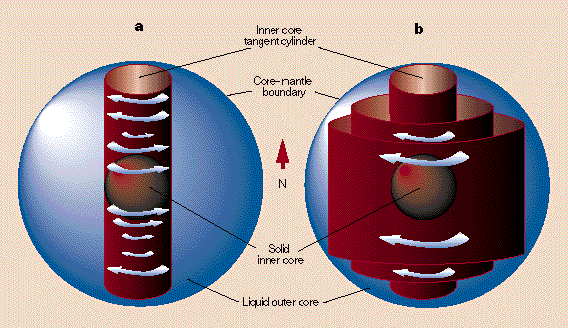
Aurora
The aurora or 'Northern lights' is one of Nature’s greatest spectacles. A display might start as a few upward shafts of light almost imperceptible against a darkening twilight sky.
Aurora
The shafts then take form, they brighten into greens topped with reds, they join to make wide curtains, move and flicker, they disappear then quickly return again. The silence as they change is somehow more eerie than the lights themselves. Sometimes the display is confined to the north, in others reds and orange cover the whole sky. Aurora are best seen for 2-3 hours around midnight although they can be visible from dusk to dawn. A moonless night well away from light pollution is ideal. They are most frequent and at their finest at high latitudes. Aurorae are concentrated in two giant ovals around* Earth’s magnetic poles. The northern pole is currentl in the high Canadian Actic and Canada, Northern USA and Northern Europe are well placed for bright displays. The auroral ovals enlarge during high activity and displays are then visible further south in England, Germany and mid latitude USA. Very exceptionally, aurora are even seen in the tropics. Aurora are produced by solar storms and are most frequent during the maximum of the 11 year solar activity cycle. The last maximum was 2000/1. Solar disturbances take 2-3 days to reach Earth and aurora are therefore to some extent predictable.
Article Src: https://www.atoptics.co.uk/highsky/auror1.htm

Earth's Magnetic Field Influence Climate
Much of the observed increase in global surface temperature over the past 150 years occurred prior to the 1940's and after the 1980's. The main agents which are invoked are solar variability, changes in atmospheric greenhouse gas content or sulfur, due to natural or anthropogenic action, or internal variability of the coupled ocean-atmosphere system.
Earth's Magnetic Field Influence Climate
Magnetism has seldom been invoked, and evidence for connections between climate and magnetic field variations have received little attention. We review evidence for such connections, starting with suggested correlations, on three time scales: recent secular variation (10-100 years), historical and archeomagnetic change (100-5000 years) and excursions and reversals (1000-1 million years). We attempt to suggest which mechanisms could account for observed correlations. Evidence for correlations in field intensity changes, excursions and reversals, which invoke Milankovic forcing in the core, either directly or through changes in ice distribution and moments of inertia of the Earth, is still tenuous. Correlation between decadal changes in amplitude of geomagnetic variations of external origin, solar irradiance and global temperature is stronger.
The correlation applies until the 1980's, suggesting that solar irradiance is the prime forcing function of climate until then, when the correlation breaks and anomalous warming may emerge from the signal. Indeed, only solar flux of energy and particles can jointly explain parallel variations in temperature and external magnetic field. The most intriguing feature may be recently proposed archeomagnetic jerks. These seem to correlate with significant climatic events. A proposed mechanism involves tilt of the dipole to low latitudes, resulting in enhanced cosmic-ray induced nucleation of clouds. Intense data acquisition over a broad range of durations is required to further probe these indications that the Earth's and Sun's magnetic fields may have significant bearing on climate change at various time scales.
Article Src: https://ui.adsabs.harvard.edu/abs/2006AGUFMGP51B..02F/abstract
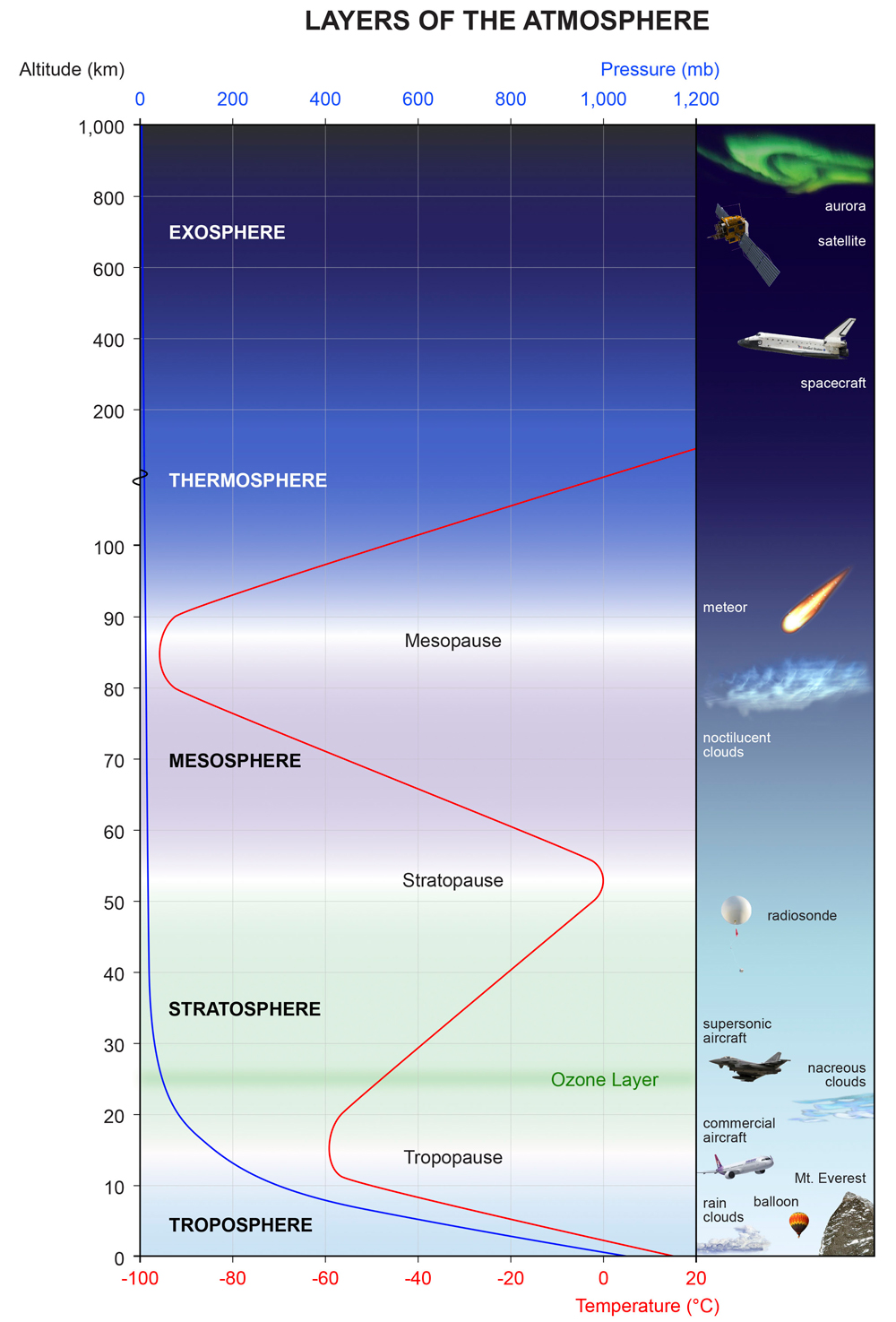
Temperature Affect Magnetism
To understand temperature effects, we need to look at the atomic structure of the elements that make up the magnet. Temperature affects magnetism by either strengthening or weakening a magnet’s attractive force.
Temperature Affect Magnetism
A magnet subjected to heat experiences a reduction in its magnetic field as the particles within the magnet are moving at an increasingly faster and more sporadic rate. This jumbling confuses and misaligns the magnetic domains, causing the magnetism to decrease. Conversely, when the same magnet is exposed to low temperatures, its magnetic property is enhanced and the strength increases. In addition to the strength of the magnet, the ease at which it can be demagnetized also varies with temperature. Like magnet strength, demagnetization resistance generally decreases with increasing temperature. The one exception is ceramic (ferrite) magnets, which are easier to demagnetize at low temperature and harder to demagnetize at high temperature. Different magnet materials react differently with temperature. Alnico magnets have the best strength stability followed by SmCo, NdFeB, and then ceramic. NdFeB magnets having the highest resistance to demagnetization (coercivity), but the largest change with temperature.
Alnico magnets have the lowest resistance to demagnetization, but the smallest change with temperature. Alnico have the highest service temperature followed by SmCo, ceramic and then NdFeB. Not everyone realizes that the shape of a magnet affects its maximum usable temperature. This is especially important for NdFeB magnets because they have the greatest change in demagnetization resistance with temperature. As the length of the magnetized axis increases, its resistance to demagnetization also increases. Like magnets, reed switch magnetism decreases at higher temperature and increases at lower temperature. This is because high temperatures increase random atomic movement and misalignment of magnetic domains. As a result, more magnetism needs to be applied to the reed switch at high temperature. In other words, the pull-in goes up as the temperature increases. Depending on the type of switch, its sensitivity (pull-in) and the temperature range, this effect can be inconsequential or significant. Do not expect all switches to track identically with temperature. There will be variations in the amount of pull-in change with temperature – less if the switch type and pull-in are the same, more if the switch type and pull-in vary.
Article Src: https://hsisensing.com/temperature-affect-magnetism/
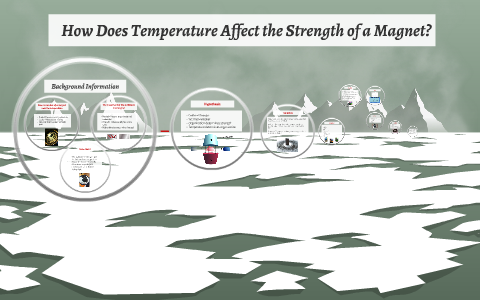
Magnetic anomaly
In geophysics, a magnetic anomaly is a local variation in the Earth's magnetic field resulting from variations in the chemistry or magnetism of the rocks. Mapping of variation over an area is valuable in detecting structures obscured by overlying material. The magnetic variation (geomagnetic reversals) in successive bands of ocean floor parallel with mid-ocean ridges was important evidence for seafloor spreading, a concept central to the theory of plate tectonics.
Magnetic anomaly
Magnetic anomalies are generally a small fraction of the magnetic field. The total field ranges from 25,000 to 65,000 nanoteslas (nT) To measure anomalies, magnetometers need a sensitivity of 10 nT or less. There are three main types of magnetometer used to measure magnetic anomalies: A. The fluxgate magnetometer was developed during World War II to detect submarines. It measures the component along a particular axis of the sensor, so it needs to be oriented. On land, it is often oriented vertically, while in aircraft, ships and satellites it is usually oriented so the axis is in the direction of the field.
It measures the magnetic field continuously, but drifts over time. One way to correct for drift is to take repeated measurements at the same place during the survey. B. The proton precession magnetometer measures the strength of the field but not its direction, so it does not need to be oriented. Each measurement takes a second or more. It is used in most ground surveys except for boreholes and high-resolution gradiometer surveys. C. Optically pumped magnetometers, which use alkali gases (most commonly rubidium and caesium) have high sample rates and sensitivities of 0.001 nT or less, but are more expensive than the other types of magnetometers. They are used on satellites and in most aeromagnetic surveys.
Article Src: https://en.wikipedia.org/wiki/Magnetic_anomaly/

You simply need to know - Facts & Figures
Life
Rock magnetism
Rock magnetism is the study of rock properties of rocks and its magnetic minerals. A very significant issue in rock magnetic studies relates to the deduction on the magnetic remanence carrier, and how the rocks became magnetized.
Rock magnetism
Iron is by far the most abundant transition element in the solar system. Largely, rock magnetic studies rely on the magnetic iron-bearing minerals: the iron-nickels (principally important for extraterrestrial magnetic studies); the iron-oxides: magnetite, maghemite, and hematite; the iron-oxyhydroxides goethite and ferrihydrite; and the iron-sulfides: greigite and pyrrhotite. Rock magnetic studies of host rocks and ore minerals produce information on the concentration, composition, and microstructure of the magnetic mineral fraction. This is important because of quantitative interpretation of detected magneto metric anomalies. This information is also needed for the investigation of problems related to the magnetic history of rocks and anomalies in the geomagnetic field, and to problems in geophysics and geochemistry. Data on rock magnetic properties can restrict the range of possible models, particularly when magnetic properties are methodically obtained as part of complementary data from geological boreholes and other geophysical information. Thus, rock magnetic parameters are crucial for a better understanding of the relationships of geology and rock magnetism and magnetic anomalies. This relation is complex because of the need of magnetic signature with respect to a rock unit, structure, lithology and geologic history. Great advances in data acquisition, processing, satellite navigation, and image processing of high-resolution aeromagnetic surveys, resulted in a critical need for a better appreciation of these relationships. Aeromagnetic surveys supply information on sources at all depths within the crust: they have been widely used for decades in mineral and petroleum exploration. Software now allows for advanced modeling. Magnetic interpretation has the potential for modeling rock bodies; however, a major restrictive factor has been the non-uniqueness of solutions of models. The two most important constraints on magnetic models are reliability of magnetic properties and of petrophysical data, and the known geological structure. Without a solid constraint, the non-uniqueness in potential field data limits the amount of information and knowledge we can retrieve from magnetic surveys.
Given the amount of money spent on acquisition of magnetic data, and the use of magnetic surveys in exploration, detailed studies of rock-magnetic properties will strongly be needed to support modeling of magnetic anomalies. At present, it is recognized that rock magnetic information assists in optimizing magnetic anomaly interpretations, especially for magnetite-bearing ores and related rocks. The intensity of remanent magnetism varies greatly in rocks and Fe-ores, and it may exceed the intensity of induced magnetization implying high Q-ratio values. Sometimes, scattered paleomagnetic directions from exposed outcrops suggest the effect of lightning strikes and imply extremely high values of magnetization. Several authors have focused on different aspects, e.g., relationships between petrology, observed aeromagnetic anomalies and physical properties to define geological and structural units and the mapping of these units to establish a correspondence between magnetic petrology and rock-magnetic properties. Basically, all materials are magnetic since they have electrons that have magnetic moments and electron’s motion results in currents with their associated magnetic fields. Magnetism is often subdivided into: induced magnetization and permanent magnetization. Induced magnetization is described by the equation M=χH where M is the magnetization, H is the magnetic field, and χ is a second order tensor denoted as the susceptibility. For example, diamagnetic material like halite, NaCl have negative while χ, paramagnetic like iron-rich olivine or fayalite, Fe2SiO4 have positive χ be understood through quantum mechanics.
Exchange energy is often designed by evaluating the nature of electron orbitals overlap. Reliant on the specifics of the electron overlap, a minimum in exchange energy often requires that adjacent atoms have parallel magnetic moments and the substance is known as ferromagnetic. With different overlap, the minimum in energy occurs when the adjacent magnetic moments are antiparallel. Then the material is denoted as antiferromagnetic when the moments are of equal magnitude and ferrimagnetic when the adjacent magnetic moments vary in magnitude. The best-known example of a ferrimagnetic mineral is magnetite). Magnetite (Fe3O4) is an example of ferrimagnetic mineral and it have an indirect exchange energy because the coupling of adjacent iron atoms arises through intervening oxygen atoms. Earth scientists attribute permanent magnetism to exchange energy and not to soul. A permanent magnetic command results from exchange energy, which combines Pauli Exclusion Principle and Coulomb interaction energy. So, exchange energy can only accurately be understood through quantum mechanics.
Article Src: DOI: 10.15406/mseij.2018.02.00026/

Human magnetic sense
Do human beings have a magnetic sense? Biologists know other animals do. They think it helps creatures including bees, turtles and birds navigate through the world.
Human magnetic sense
Scientists have tried to investigate whether humans belong on the list of magnetically sensitive organisms. For decades, there’s been a back-and-forth between positive reports and failures to demonstrate the trait in people, with seemingly endless controversy. The mixed results in people may be due to the fact that virtually all past studies relied on behavioral decisions from the participants. If human beings do possess a magnetic sense, daily experience suggests that it would be very weak or deeply subconscious. Such faint impressions could easily be misinterpreted – or just plain missed – when trying to make decisions. The Earth is surrounded by a magnetic field, generated by the movement of the planet’s liquid core. It’s why a magnetic compass points north. At Earth’s surface, this magnetic field is fairly weak, about 100 times weaker than that of a refrigerator magnet. Over the past 50 years or so, scientists have shown that hundreds of organisms in nearly all branches of the bacterial, protist and animal kingdoms have the ability to detect and respond to this geomagnetic field.
In some animals – such as honey bees – the geomagnetic behavioral responses are as strong as the responses to light, odor or touch. Biologists have identified strong responses in vertebrates ranging from fish, amphibians, reptiles, numerous birds and a diverse variety of mammals including whales, rodents, bats, cows and dogs – the last of which can be trained to find a hidden bar magnet. In all of these cases, the animals are using the geomagnetic field as components of their homing and navigation abilities, along with other cues like sight, smell and hearing. Skeptics dismissed early reports of these responses, largely because there didn’t seem to be a biophysical mechanism that could translate the Earth’s weak geomagnetic field into strong neural signals. This view was dramatically changed by the discovery that living cells have the ability to build nanocrystals of the ferromagnetic mineral magnetite – basically, tiny iron magnets. Biogenic crystals of magnetite were first seen in the teeth of one group of mollusks, later in bacteria, and then in a variety of other organisms ranging from protists and animals such as insects, fish and mammals, including within tissues of the human brain.
Article Src: https://theconversation.com/new-evidence-for-a-human-magnetic-sense-that-lets-your-brain-detect-the-earths-magnetic-field-113536

Magnetic effects on humans
Can small (1 mG) magnetic fields affect humans? No.
Magnetic effects on humans
An electronic current betrays its presence by generating its own magnetic field. Numerous electrical appliances in a kitchen will generate at a short distance of 0.3m a magnetic field of 1 mG. Moving a magnet across electrical wires in a bike’s dynamo will produce enough electricity to light up a lamp. In a 5-year, various magnetic field levels and configurations in residential homes, ranging in intensity from 0.1 mTesla =1 mG, up to 1 mTesla =10 mG, and with various shapes (thickness of electrical wires, distance of wires), have been carefully tested with over 1200 children, and the results showed no biological effects. All putative biological side effects due to small magnetic fields <10 mG have remained unproven so far (being too weak or negligible), and putative magnetic effects on our dreams are still unproven.
Article Src: doi:10.1016 /S1387-6473(03)00060-5
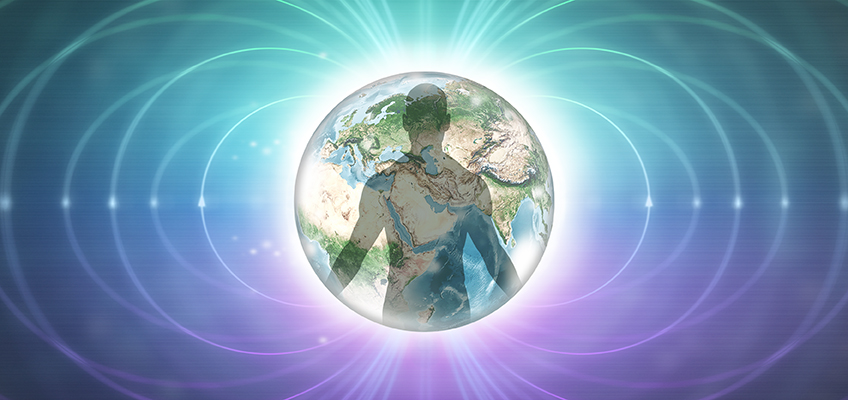
Animals sense Earth's magnetic field
The secrets behind magnetoreception—that is, the ability of some animals to sense Earth's magnetic field—are beginning to gradually unravel, thanks in part to a new study that demonstrates magnetic sensitivity in a completely artificial protein, which will help guide further study into what makes this phenomenon possible.
Animals sense Earth's magnetic field
If you have ever wondered how homing pigeons make round trips without GPS, or how pregnant sea turtles find the same beach on which they were born decades earlier to lay their own eggs, it is all thanks to their sense of magnetoreception. The genesis of this sense, which is also found in birds, lobsters, rainbow trout, newts, mole-rats and other animals, as well as many plants, has long stymied researchers, but a recent study by scientists from the University of Pennsylvania, Temple University, and the University of Oxford provides new insight into a biophysical process known as the radical pair mechanism, which may be a protein-based basis of magnetoreception. There are three basic theories for how magnetoreception works, and they might all be accurate, depending on the animal. The first involves magnetic minerals. Bacteria and phytoplankton generate biological magnetite crystals that allow them to sense Earth's magnetic field. Researchers also believe that birds have them in their beaks. The second theory, electromagnetic induction, involves animals sensitive to electric charges, such as aquatic animals, that have an internal cellular or neural mechanism that converts electro-receptivity into magnetic sensitivity. The third theory involves a biochemical reaction that generates radical pairs—quantum entangled molecules with unpaired electrons. Proteins called cryptochromes form radical pairs after they've been activated by energy absorption. Cryptochromes may hold a key to understanding the origin of magnetoreception in birds, which have cryptochromes in their eyes.
When an electron transfer occurs between two molecules, it leaves two unpaired electrons, one on each molecule. The back-transfer of an electron to the original molecule requires the quantum spin of those electrons to be opposite (one spin up and one spin down). Those spins are always changing between the up and down states and their rates of change can be influenced by a magnetic field. In cryptochromes, radical pairs form from the singlet state, meaning that both unpaired electrons in the radical pair have opposite spins. When a radical pair enters the triplet state, in which both unpaired electrons have the same spin (both up or both down), back-electron transfer is not possible until the radical pair returns to the singlet state. Therefore, the magnetic field is able to influence how long the radical pair is around.
Article Src: https://phys.org/news/2020-05-animals-earth-magnetic-field.html

Magnetosensitive animals
Magnetosensitive animals literally have a compass in their bodies. Compasses work because their needles are basically magnets that align with the Earth’s magnetic field. Could animals also have tiny magnets inside their bodies?
Magnetosensitive animals
Tiny magnetic particles composed of a mineral called magnetite have been shown to mediate magnetosensation in bacteria. These particles are contained within structures called magnetosomes and are arranged in a linear chain. When they align with the Earth’s magnetic field, they literally rotate the bacterium’s body to aim it toward the bottom layers of the sediment. Magnetite chains have also been identified in salmon, pigeons, and other animals, suggesting they may represent a general mechanism of magnetosensation. In these animals they are found within tiny spaces in the head associated with the trigeminal nerve, which conveys information about touch, temperature, and pain from the face to the brain. So if this nerve is sensitive to movements of magnetite particles in the head, it might also convey a sense of the magnetic field.
Article Src: https://www.brains-explained.com/how-animals-sense-magnetism/

Bats Use Magnetite
The role of the earth’s magnetic field for orientation and navigation has been confirmed in several animal taxa, including birds, insects, lobsters, salamanders, turtles, fish and mammals , including–most recently–bats.
Bats Use Magnetite
Recently, the big brown bat, Eptesicus fuscus, was shown to possess a magnetic compass for homing, but the mechanistic nature of this compass remained unknown. From an ecological perspective bats compare closely with birds in terms of their ability to make rapid, wide ranging movements. Also like birds, some bats make seasonal migrations spanning many 1000’s of km. Previous experiments have indicated that vision is essential for homing in bats beyond the range of their echolocation system, suggesting the possibility that bats have a light mediated magnetic compass. However, bats have also been shown to have magnetite in their bodies, although it has not yet been linked to sensory neurons as in other vertebrates. Previous experiments using these transmitters have demonstrated the use of a magnetic compass in both bats and birds.
Article Src: doi:10.1371/journal.pone.0001676/

The most powerful magnet
At the National High Magnetic Field Laboratory, they've just build the most powerful superconducting magnet ever, shattering the world record.
The most powerful magnet
Its magnetic field clocks in at 32 tesla in strength. That's 33 percent higher than the previous record, and 3,000 times stronger than a small fridge magnet, making this a larger increase than all the improvements in superconducting magnets from the last 40 years combined. "This is a transformational step in magnet technology, a true revolution in the making," said MagLab Director Greg Boebinger. "Not only will this state-of-the-art magnet design allow us to offer new experimental techniques here at the lab, but it will boost the power of other scientific tools such as X-rays and neutron scattering around the world." The new magnet is called the 32T, and it's made of a combination of low-temperature and high-temperature superconductors - materials that conduct electricity frictionlessly, as opposed to a material such as copper, which loses power and generates heat in the process. Magnets that are made of these resistive materials are called resistive magnets, and they can be very powerful; in fact, MagLab created (another record-breaking) one earlier this year that generates a magnetic field of 41.4 tesla. But because they lose so much energy, the energy requirements to power them are much higher than what is needed for a superconducting magnet. That 41.4-tesla magnet takes a whopping 32 megawatts of direct current power to run. Low-temperature superconductivity was discovered in 1911, but it's not without limitations. As the name suggests, it only works below a certain temperature threshold - usually around 20 Kelvin (-253.15 Celsius or -423.67 Fahrenheit). This means that the superconducting magnets that power MRI machines in hospitals require liquid helium to keep the magnet at operating temperature - a costly solution, but still more economical than the power requirements of a resistive magnet of the same strength.
These low-temperature superconductors also stop working at magnetic fields higher than about 25 tesla. But then high-temperature superconductivity was discovered by IBM researchers Georg Bednorz and K. Alex Müller in 1986. Not only do high-temperature superconductors work at a wider range of temperatures ("high" being relative), they also work in stronger magnetic fields. By combining the two, the team at MagLab were able to create a powerful superconducting magnet that overcomes the limitations of low-temperature materials. 32T uses a conventional low-temperature superconductor, and a high-temperature superconductor called YBCO made of yttrium, barium, copper and oxygen, which has a critical temperature of about 93 Kelvin (-180 Celsius or -292 Fahrenheit - we told you it was relative). The magnet took years to design, and the team developed new techniques for insulating, reinforcing, and de-energising the system. Now that they have those techniques, they can try to develop the magnet even further. "We've opened up an enormous new realm," said Huub Weijers, who oversaw the magnet's construction. "I don't know what that limit is, but it's beyond 100 tesla. The required materials exist. It's just technology and dollars that are between us and 100 tesla." The new magnet will be available for use to visiting scientists from next year, and is expected to help break new ground in a variety of areas, including chemistry, biology, physics, and quantum matter.
Article Src: https://www.sciencealert.com/world-s-strongest-superconducting-magnet-32-tesla-record/

The field of Magnetic Resonance Imaging (MRI)
Magnetic Resonance Imaging (MRI) is used to produce diagnostic, cross-sectional images of the body to aid clinical diagnosis.
The field of Magnetic Resonance Imaging (MRI)
The weak magnetic field of the earth, measured in either Gauss (G) or Tesla (T), is approximately 0.3 G at the equator and 0.7 G at the poles with 10,000 G being equal to 1 T. In perspective a common household fridge magnet ranges from 35 to 200 G and a magnetic therapy bracelet ranges from 300 to 5000 G. Most magnets used in MRI scanners are electrically induced although some permanent magnets are still in use. At static field strengths greater than 0.5 T the type of electromagnet most commonly used is superconducting. Superconducting magnets use a coil of alloy wire that offers virtually no impedance at zero degrees centigrade. Initially a current is passed through the coil to generate the magnetic field then the wire is cryogenically cooled, usually with liquid Helium, and the magnetic field is maintained without any additional power. Europe’s first clinical MRI scanner was installed in the United Kingdom in 1983 and by 2005 there were approximately 230 MRI scanners in NHS hospitals6 along with 12 mobile MRI scanners nationally. Although MRI is a safe non-invasive imaging modality requiring no exposure to harmful ionising radiation it requires exposure to the above mentioned static magnetic fields, time-varying electromagnetic field gradients, and pulsed RF electromagnetic fields.
Exposure to these differing types of electromagnetic fields brings about numerous potential hazards. These electromagnetic fields will interact with the properties of any material introduced into the field proximity and interaction with living biological tissue will predominantly take place at a cellular level. Interaction with material that cannot be permanently magnetised is dependent upon magnetic susceptibility. Presently the majority of MRI scanners in clinical use have a static magnetic field strength of 1.5 T. At these field strengths the safety issues surrounding the use of MRI have been researched and documented.9 Medical technology advancement has now enabled the static magnetic field strength in clinical MR imaging to reach levels greater than 3 T. This increase requires that the safety issues surrounding the use of MRI be revisited. The development of higher field strength MRI systems has absolutely created new issues regarding MRI safety.
Article Src: doi:10.1016/j.radi.2009.07.004/

Mobiles' magnetic fields
Mobile phones are unlikely to harm human health”, adding to the ongoing, and often conflicting, coverage of the potential health impact of environmental exposure to what some people have called “electromagnetic smog”.
Mobiles' magnetic fields
This is a term used to refer to a mix of low-level electromagnetic fields that exist in the modern environment. This "smog" is not just generated by mobile phones, but also by Wi-Fi routers, tablets, laptops, power lines and cell towers. In the modern world, you are never far away from a manmade magnetic field. Concerns regarding the impact of exposure to environmental magnetic fields on human health have existed for decades. While observational studies have suggested that there is an association between such exposure and certain diseases, no studies have demonstrated a direct causal link. Part of the difficulty in determining whether there is a direct effect is the lack of an established mechanism of action by which magnetic fields could plausibly bring about changes in the biochemical processes that occur in the body. The most plausible mechanism of action is known as the radical pair mechanism.
A "radical" is an atom or molecule that is chemically reactive due to the presence of an unpaired electron. Some biochemical processes produce brief radicals as an intermediate step in the longer process. Processes that involve, or are thought to involve, pairs of these radicals were used in this research. Latest studies investigated whether exposure to weak magnetic fields (WMFs) alters processes in a class of enzymes known or thought to involve radical pairs, which could potentially damage cells. The researchers found that these reactions were not sensitive to magnetic fields.
Article Src: https://www.nhs.uk/news/lifestyle-and-exercise/do-mobiles-magnetic-fields-harm-humans//

Magnetic refrigeration
Magnetic refrigeration is an evolving cooling technology that has the potential of high energy efficiency using environmentally friendly refrigerants.
Magnetic refrigeration
Magnetic refrigeration utilizes the magnetocaloric effect (MCE), which is the temperature change that most magnetic materials exhibit when subjected to a changing magnetic field. This temperature change is called the adiabatic temperature change, ΔTad, and is a function of temperature and magnetic field. The temperature change is greatest near the Curie temperature, Tc, which is different for different magnetocaloric materials. Because the MCE in the best magnetocaloric materials currently available exhibit a temperature change of no more than 4 K in a magnetic field of 1 T, a magnetic refrigeration device must utilize a regenerative process to produce a large enough temperature span to be useful for refrigeration purposes.
The most utilized process for this is called active magnetic regeneration (AMR). At present, a great number of magnetic refrigeration test devices have been built and examined in some detail, with focus on the produced temperature span and cooling power of the devices. So far the magnet, a key component in the magnetic refrigeration system, has been largely overlooked, even though it is often the single most expensive part of a magnetic refrigerator. Also little effort has been made to compare existing magnet designs in order to learn to design more efficient magnetic structures.
Article Src: http://dx.doi.org/10.1016/j.ijrefrig.2009.12.012
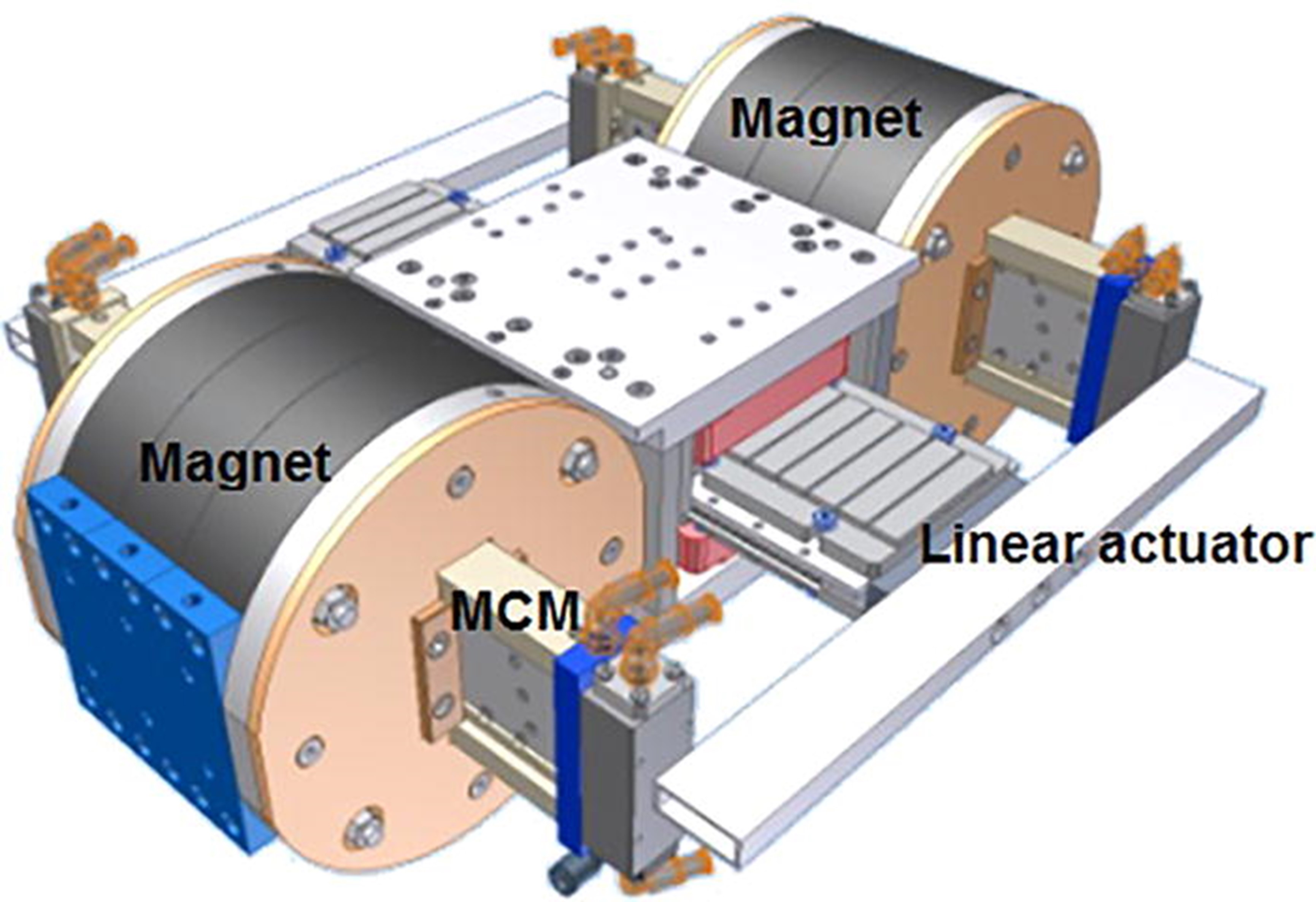
Magnetic moment of proton and neutron.
The value of the Magnetic moment of proton and neutron, expressed in nuclear magnetons, has become of special interest because of its importance in present-day methods of evaluating the best values of the fundamental atomic constants.
Magnetic moment of proton and neutron
Precise knowledge of the fundamental properties of the proton is essential for our understanding of atomic structure as well as for precise tests of fundamental symmetries. There are reports on a direct high-precision measurement of the magnetic moment μp of the proton in units of the nuclear magneton μN.
In 2014 a direct measurement of the magnetic moment of the proton gave 2.792847350(9) nuclear magnetons. Efforts are underway to measure the magnetic moment of the antiproton with comparable accuracy, since a measured difference between the proton and antiproton could be a valuable clue toward unraveling the mystery of why matter greatly dominates antimatter in the universe (antimatter problem).
Neutron: g = -3.8260837 +/- 0.0000018
The proton g-factor is far from the gS = 2 for the electron, and even the uncharged neutron has a sizable magnetic moment! For the neutron, this suggests that there is internal structure involving the movement of charged particles, even though the net charge of the neutron is zero. If g=2 were an expected value for the proton and g=0 were expected for the neutron, then it was noted by early researchers that the the proton g-factor is 3.6 units above its expected value and the neutron value is 3.8 units below its expected value. This approximate symmetry was used in trial models of the magnetic moment, and in retrospect is taken as an indication of the internal structure of quarks in the standard model of the proton and neutron.
Note that the maximum effective magnetic moment of a nucleus in nuclear magnetons will be the g-factor multiplied by the nuclear spin. For a proton with g = 5.5857 the quoted magnetic moment is μ = 2.7928 nuclear magnetons.
Article Src: https://science.sciencemag.org/content/358/6366/1081
http://hyperphysics.phy-astr.gsu.edu/hbase/Nuclear/nspin.html
